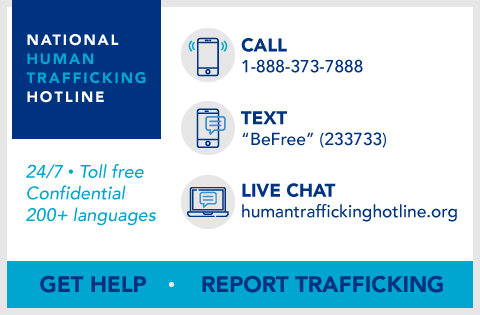Human Trafficking is a crime involving the exploitation of someone for the purposes of compelled labor or a commercial sex act through the use of force, fraud, or coercion. Where a person younger than 18 is induced to perform a commercial sex act, it is a crime regardless of whether there is any force, fraud, or coercion.
Specially, within the Department of Labor's purview, labor trafficking encompasses the range of activities – recruiting, harboring, transporting, providing, or obtaining – involved when a person uses force or physical threats; psychological coercion; abuse of the legal process; a scheme, plan, or pattern intended to hold a person in fear of serious harm; or other coercive means to compel someone to work. Once a person's labor is obtained by such means, the person's previous consent or effort to obtain employment with the trafficker does not preclude the person from being considered a victim, or the government from prosecuting the offender. U.S. law prohibits the importation of goods produced by forced labor, including forced child labor; convict labor; and indentured labor under penal sanctions.

Who is most at risk?
Victims can be anyone from around the world or right next door: adults and children of any sex or citizenship status. Significant risk factors include economic hardship, recent migration or relocation, substance use, mental health concerns, involvement with the child welfare system and being a runaway or homeless youth. Often, traffickers identify and leverage their victims' vulnerabilities in order to create dependency.
Spotting human trafficking indicators
Everyone has the potential to discover a human trafficking situation. Victims may be right in front of us at, for example, construction sites, restaurants, elder care centers, nail salons, agricultural fields and hotels. Traffickers' use of coercion – such as threats of deportation and harm to the victim or their family members – is so powerful that even if you reach out to victims, they may be too fearful to accept your help. Knowing indicators of human trafficking will help you act on your gut feeling that something is wrong and report it.
While the following is not an exhaustive list, these are some key red flags that could alert you to a potential trafficking situation that should be reported. Each individual indicator should be taken into context and may not imply a trafficking situation. Not all victims of human trafficking will exhibit these signs. Additional signs are detailed here.
- A worker living with their employer
- Poor living conditions
- Owe money to an employer or recruiter
- Worker feels pressured to stay in a work situation they wish to leave.
- Multiple people working or living in a cramped space
- Inability to speak to another individual alone
- A person's answers appear to be scripted and rehearsed
- An employer is holding identity documents (such as a worker's passport, work visa, etc.)
- A person shows signs of physical abuse
- A person is fearful
- A worker is unpaid or paid very little
- A person is under the age of 18 and engages in commercial sex work
